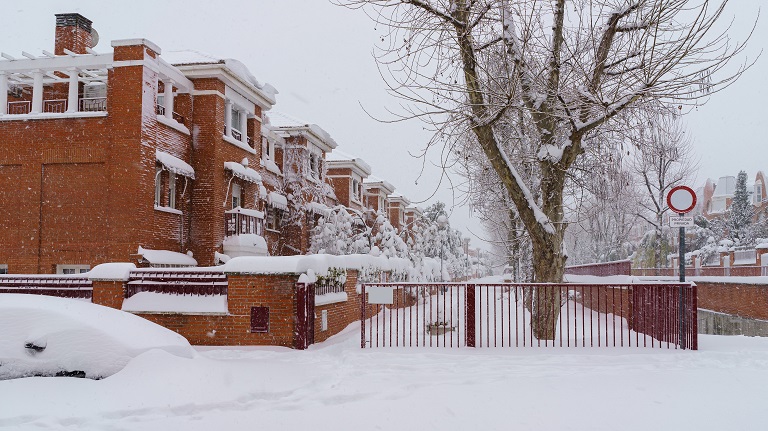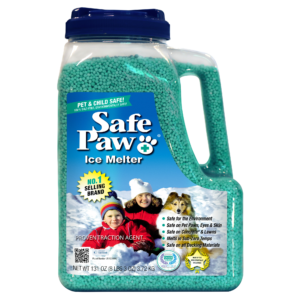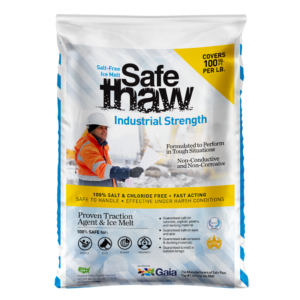Apartment Building Does Not Salt Properly? Do This!

Did you know approximately one million Americans are injured every year and nearly 600,000 hospitalized every year due to falls on ice? Slippery surface traction causes people to lose their balance, thus, resulting in a painful fall. As per other statistics, falls account for 64% of insurance claims and nearly 20% of all spinal cord injuries in Americans every year.
In winter, you know how slippery and icy surfaces can get. Therefore, landlords and property managers have to constantly ensure the safety of tenants and look for solutions to add traction on stairs, walkways, driveways, areas around the building, and much more.
Concrete and snow are a dangerous combination that can result in slippery surface traction. As snow melts, the excess residue tends to seep into the crevices of the concrete, thus damaging it.
One of the most popular methods used by apartment buildings to melt snow and provide traction is Rock Salt or Sodium Chloride. It is an easily accessible product available in almost every hypermarket across the country. It melts ice over a more extended period and works well for temperatures up to -20 or -25 degrees Fahrenheit. It ideally takes about 20 to 25 minutes for the Rock Salt to melt snow below freezing temperature.
Get ready for winter with the ONLY Pet Safe Ice Melt you can trust
However, apartment buildings need to increase traction on slippery surfaces and thus apply alternate methods, such as –
- Grit– Another popular method to increase the traction of slippery surfaces is Grit. Made of a combination of sand, gravel, and birdseed, it helps in making stairs and walkways less slippery. But it can create a mess as you enter your apartment and home because it sticks to the soles of the shoes.
- Kitty Litter– It is yet another conventional method to provide traction for stairs and places around the building. However, it leaves a residue on your shoe and ends up going inside your house, leaving a slight stench.
- Calcium Magnesium Acetate– Another alternative to traditional snow melting methods in apartment buildings is CMA or Calcium Magnesium Acetate. This is specifically designed to suit the environment and is less damaging to the concrete but can provide respite up to -20 degrees Fahrenheit temperature only.
Another less popular but extremely effective method to help apartment buildings tackle their snow and ice problem is using a non-toxic traction agent. This agent includes a combination of crushed volcanic rocks and other milled and dried natural geo-crystals. These crystals act as anti-slip agents, give a good grip on any icy surface and provide good traction for stairs.
The absorbers in Traction Magic absorb the liquid on the ice making it less slippery. The grippers, another granule component, then use their gripping capacity to attach themselves to the ice.
Getting Safe Traction on Snow Ice
Snow ice—that sneaky blend of snow packed down into a glassy, frozen surface—is the stuff winter nightmares are made of. You step onto what looks like snow, and next thing you know, you’re skidding like you’re on a rink. For drivers, it’s even worse. Suddenly, you’re googling how to get traction in snow while praying your brakes respond.
The trick to surviving snow ice isn’t just good tires. It’s preparation. This is where traction agents come in. Products like ice Traction Magic don’t try to melt the ice—instead, they transform the surface by adding gritty texture immediately. That means instant grip whether you’re walking, driving, or trying to free a stuck car. And it doesn’t damage your driveway, garden, or your dog’s paws.
One of the biggest myths in winter driving is whether traction control helps or hurts. Many people ask, should I turn traction control off in snow? The answer depends on the situation. On soft snow or when you’re stuck, turning it off can help you rock your car out. But when you’re on slick, snow ice, traction control helps prevent your wheels from spinning out of control. It’s not a magic fix—but paired with an external traction product, it gives you a fighting chance.
How Cold Does It Have to Be for Snow Ice to Become Black Ice?
Here’s the catch: snow ice doesn’t always stay just snow ice. Given the right temperature drop, it can transition into something even scarier—black ice. But how cold does it have to be for black ice to form? Generally, black ice appears when temperatures fall below 32°F (0°C), especially in early morning or late evening hours. Even if the sun has been out, residual moisture from snow can refreeze into a thin, nearly invisible layer.
This makes knowing what is black ice on roads essential. It’s not black—it’s transparent and blends in with asphalt, making it almost impossible to see. And if you think your anti-lock brakes or winter tires alone can handle it, think again. That’s why an instant traction solution becomes essential. It works whether you’re walking across your driveway or trying to keep your delivery van on course.
When snow transitions into ice, and ice into black ice, your window to act safely shrinks fast. A smart solution like a traction agent gives you back that control—without the wait or the worry of damaging your property.
Conclusion
Snow may look beautiful falling—but once it compacts into snow ice, it turns into a hazard for everyone. And when the temps drop further, you’re facing black ice—hidden, dangerous, and all too common. By understanding how to get traction in snow and when to turn off traction control, you’re halfway prepared. But the real solution? A traction product that works instantly. Whether it’s your sidewalk, driveway, or tires, make sure you’re not just hoping for safety this winter—you’re prepared for it.
Get ready for winter with the ONLY Pet Safe Ice Melt you can trust
Other Ice Melt Products
Safe Paw
The Original and the #1 Pet and Child Safe Ice Melt for over 20 years. Guaranteed environmentally safe – will not harm waterways and sensitive wetlands. Safe Paw can change how winter affects our planet.

Safe Thaw
Imagine an ice melt you can put down and never worry about. It won’t harm pets, kids and your property. That’s Safe Thaw. Unlike anything else on the market, Safe Thaw can change how winter affects our planet.
